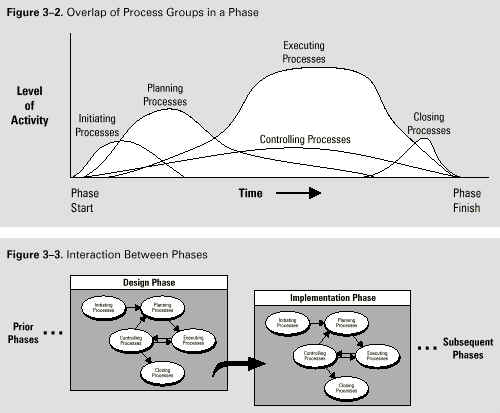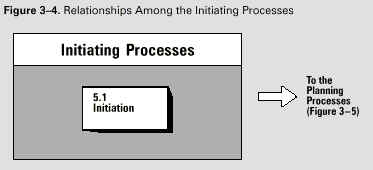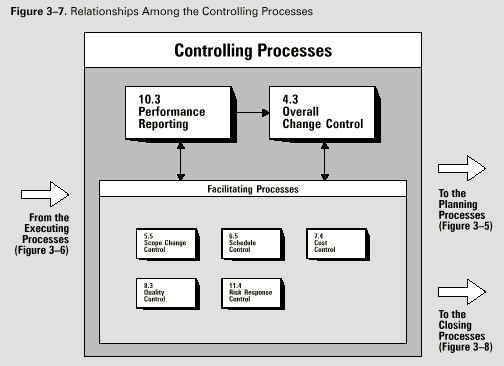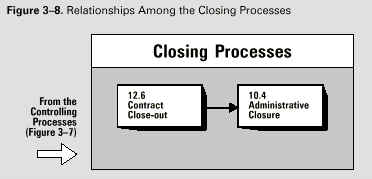3
Project
Management
Processes |
Project management is an
integrative endeavor—an action, or failure to take
action, in one area will usually affect other areas. The
interactions may be straightforward and well-understood,
or they may be subtle and uncertain. For example, a scope
change will almost always affect project cost, but it may
or may not affect team morale or product quality.
These interactions often require trade-offs among project
objectives—performance in one area may be enhanced
only by sacrificing performance in another. Successful
project management requires actively managing these
interactions. To help in understanding the integrative
nature of project management, and to emphasize the
importance of integration, this document describes
project management in terms of its component processes
and their interactions. This chapter provides an
introduction to the concept of project management as a
number of interlinked processes and thus provides an
essential foundation for understanding the process
descriptions in Chapters 4 through 12. It includes the
following major sections:
3.1 Project Processes
3.2 Process Groups
3.3 Process Interactions
3.4 Customizing Process Interactions
|
3.2
Process
Groups |
Project management processes can be organized into five
groups of one or more processes each:
- Initiating
processes—recognizing that a project or
phase should begin and committing to do so.
- Planning
processes—devising and maintaining a
workable scheme to accomplish the business need
that the project was undertaken to address.
- Executing
processes—coordinating people and other
resources to carry out the plan.
- Controlling
processes—ensuring that project objectives
are met by monitoring and measuring progress and
taking corrective action when necessary.
- Closing
processes—formalizing acceptance of the
project or phase and bringing it to an orderly
end.
The process groups are
linked by the results they produce—the result or
outcome of one becomes an input to another. Among the
central process groups, the links are
iterated—planning provides executing with a
documented project plan early on, and then provides
documented updates to the plan as the project progresses.
These connections are illustrated in Figure 3–1.
In addition, the project management process groups are
not discrete, one-time events; they are overlapping
activities which occur at varying levels of intensity
throughout each phase of the project. Figure 3–2 illustrates
how the process groups overlap and vary within a phase.
Finally, the process group interactions also cross phases
such that closing one phase provides an input to
initiating the next. For example, closing a design phase
requires customer acceptance of the design document.
Simultaneously, the design document defines the product
description for the ensuing implementation phase. This
interaction is illustrated in Figure 3–3.
Repeating the initiation processes at the start of each
phase helps to keep the project focused on the business
need it was undertaken to address. It should also help
ensure that the project is halted if the business need no
longer exists or if the project is unlikely to satisfy
that need. Business needs are discussed in more detail in
the introduction to Section 5.1, Initiation.

Although Figure
3–3 is drawn with discrete phases and discrete
processes, in an actual project there will be many
overlaps. The planning process, for example, must not
only provide details of the work to be done to bring the
current phase of the project to successful completion but
must also provide some preliminary description of work to
be done in later phases. This progressive detailing of
the project plan is often called rolling wave planning.
|
3.3
Process
Interactions |
Within each process
group, the individual processes are linked by their
inputs and outputs. By focusing on these links, we can
describe each process in terms of its:
- Inputs—documents
or documentable items that will be acted upon.
- Tools and
techniques—mechanisms applied to the inputs
to create the outputs.
- Outputs—documents
or documentable items that are a result of the
process.

The project management
processes common to most projects in most application
areas are listed here and described in detail in Chapters
4 through 12. The numbers in parentheses after the
process names identify the chapter and section where it
is described. The process interactions illustrated here
are also typical of most projects in most application
areas. Section 3.4 discusses customizing both process
descriptions and interactions.
3.3.1 Initiating Processes
Figure 3–4 illustrates the single process in
this process group. Initiation (5.1)—committing the
organization to begin the next phase of the project.
3.3.2 Planning Processes
Planning is of major importance to a project
because the project involves doing something which has
not been done before. As a result, there are relatively
more processes in this section. However, the number of
processes does not mean that project management is
primarily planning—the amount of planning performed
should be commensurate with the scope of the project and
the usefulness of the information developed.
The relationships among the project planning processes
are shown in Figure 3–5 (this chart is an
explosion of the ellipse labeled "planning
processes" in Figure 3–1). These
processes are subject to frequent iterations prior to
completing the plan. For example, if the initial
completion date is unacceptable, project resources, cost,
or even scope may need to be redefined. In addition,
planning is not an exact science—two different teams
could generate very different plans for the same project.
Core processes. Some planning processes have clear
dependencies that require them to be performed in
essentially the same order on most projects. For example,
activities must be defined before they can be scheduled
or costed. These core planning processes may be
iterated several times during any one phase of a project.
They include:
- Scope Planning
(5.2)—developing a written scope statement
as the basis for future project decisions.
- Scope Definition
(5.3)—subdividing the major project
deliverables into smaller, more manageable
components.
- Activity Definition
(6.1)—identifying the specific activities
that must be performed to produce the various
project deliverables.
- Activity Sequencing
(6.2)—identifying and documenting
interactivity dependencies.
- Activity Duration
Estimating (6.3)—estimating the number of
work periods which will be needed to complete
individual activities.
- Schedule Development
(6.4)—analyzing activity sequences, activity
durations, and resource requirements to create
the project schedule.
- Resource Planning
(7.1)—determining what resources (people,
equipment, materials) and what quantities of each
should be used to perform project activities.
- Cost Estimating
(7.2)—developing an approximation (estimate)
of the costs of the resources needed to complete
project activities.
- Cost Budgeting
(7.3)—allocating the overall cost estimate
to individual work items.
- Project Plan
Development (4.1)—taking the results of
other planning processes and putting them into a
consistent, coherent document.

Facilitating processes. Interactions among the
other planning processes are more dependent on the nature
of the project. For example, on some projects there may
be little or no identifiable risk until after most of the
planning has been done and the team recognizes that the
cost and schedule targets are extremely aggressive and
thus involve considerable risk. Although these facilitating
processes are performed intermittently and as needed
during project planning, they are not optional. They
include:
- Quality Planning
(8.1)—identifying which quality standards
are relevant to the project and determining how
to satisfy them.
- Organizational
Planning (9.1)—identifying, documenting, and
assigning project roles, responsibilities, and
reporting relationships.
- Staff Acquisition
(9.2)—getting the human resources needed
assigned to and working on the project.
- Communications
Planning (10.1)—determining the information
and communications needs of the stakeholders: who
needs what information, when will they need it,
and how will it be given to them.
- Risk Identification
(11.1)—determining which risks are likely to
affect the project and documenting the
characteristics of each.
- Risk Quantification
(11.2)—evaluating risks and risk
interactions to assess the range of possible
project outcomes.
- Risk Response
Development (11.3)—defining enhancement
steps for opportunities and responses to threats.
- Procurement Planning
(12.1)—determining what to procure and when.
- Solicitation Planning
(12.2)—documenting product requirements and
identifying potential sources.
3.3.3 Executing Processes
The executing processes include core processes
and facilitating processes as described in Section 3.3.2,
Planning Processes. Figure 3–6 illustrates
how the following processes interact:
- Project Plan
Execution (4.2)—carrying out the project
plan by performing the activities included
therein.
- Scope Verification
(5.4)—formalizing acceptance of the project
scope.
- Quality Assurance
(8.2)—evaluating overall project performance
on a regular basis to provide confidence that the
project will satisfy the relevant quality
standards.
- Team Development
(9.3)—developing individual and group skills
to enhance project performance.
- Information
Distribution (10.2)—making needed
information available to project stakeholders in
a timely manner.
- Solicitation
(12.3)—obtaining quotations, bids, offers,
or proposals as appropriate.
- Source Selection
(12.4)—choosing from among potential
sellers.
- Contract
Administration (12.5)—managing the
relationship with the seller.
3.3.4 Controlling
Processes
Project performance must be measured regularly
to identify variances from the plan. Variances are fed
into the control processes in the various knowledge
areas. To the extent that significant variances are
observed (i.e., those that jeopardize the project
objectives), adjustments to the plan are made by
repeating the appropriate project planning processes. For
example, a missed activity finish date may require
adjustments to the current staffing plan, reliance on
overtime, or trade-offs between budget and schedule
objectives. Controlling also includes taking preventive
action in anticipation of possible problems.

The controlling process
group contains core processes and facilitating processes
as described in Section 3.3.2, Planning Processes. Figure
3–7 illustrates how the following processes
interact:
- Overall Change
Control (4.3)—coordinating changes across
the entire project.
- Scope Change Control
(5.5)—controlling changes to project scope.
- Schedule Control
(6.5)—controlling changes to the project
schedule.
- Cost Control
(7.4)—controlling changes to the project
budget.
- Quality Control
(8.3)—monitoring specific project results to
determine if they comply with relevant quality
standards and identifying ways to eliminate
causes of unsatisfactory performance.
- Performance Reporting
(10.3)—collecting and disseminating
performance information. This includes status
reporting, progress measurement, and forecasting.
- Risk Response Control
(11.4)—responding to changes in risk over
the course of the project.

3.3.5 Closing
Processes
Figure 3–8 illustrates how the
following processes interact:
- Administrative
Closure (10.4)—generating, gathering, and
disseminating information to formalize phase or
project completion.
- Contract Close-out
(12.6)—completion and settlement of the
contract, including resolution of any open items.
|
3.4
Customizing
Process
Interactions
|
The processes identified and the interactions
illustrated in Section 3.3 meet the test of general
acceptance—they apply to most projects most of the
time. However, not all of the processes will be needed on
all projects, and not all of the interactions will apply
to all projects. For example:
- An organization that
makes extensive use of contractors may explicitly
describe where in the planning process each
procurement process occurs.
- The absence of a
process does not mean that it should not be
performed. The project management team should
identify and manage all the processes that are
needed to ensure a successful project.
- Projects which are
dependent on unique resources (commercial
software de-velopment, biopharmaceuticals, etc.)
may define roles and responsibilities priorto
scope definition since what can be done may be a
function of who will beavailable to do it.
- Some process outputs
may be predefined as constraints. For example,
managementmay specify a target completion date
rather than allowing it to be determined by the
planning process.
- Larger projects may
need relatively more detail. For example, risk
identification might be further subdivided to
focus separately on identifying cost risks,
schedule risks, technical risks, and quality
risks.
- On subprojects and
smaller projects, relatively little effort will
be spent on processes whose outputs have been
defined at the project level (e.g., a
subcontractor may ignore risks explicitly assumed
by the prime contractor) or on processes that
provide only marginal utility (there may be no
formal communicationsplan on a four-person
project).
When there is a need to
make a change, the change should be clearly identified,
carefully evaluated, and actively managed.

|






